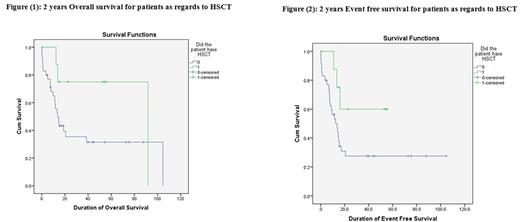Abstract
INTRODUCTION: Myelodysplastic syndrome (MDS) is an uncommon disorder accounting for less than 5% of hematopoietic neoplasia in childhood. Although many therapeutic options have been attempted for pediatric MDS including immunosuppressive therapy, epigenetic modifying agents, high-dose chemotherapy, and hematopoietic growth factors, but still hematopoietic stem cell transplant (HSCT) is the only curative therapy for those patients. We described the outcome of pediatric patients with MDS and the factors affecting the overall survival (OS) and event free survival (EFS). METHODS: This is a retrospective descriptive study included newly diagnosed patients with MDS who presented to Children Cancer Hospital Egypt (CCHE-57357), between July 2007 and December 2015, and were followed till June 2017. Patients with congenital (inherited) marrow failure syndromes were excluded. All patients were reviewed for the diagnostic criteria according the WHO classification. Wait and see approach was adopted for patients with Refractory Cytopenia of Childhood (RCC) who had normal karyotype and were transfusion independent. HSCT was offered to patients who had HLA matched family donors after HLA typing. They received myeloablative conditioning therapy followed by stem cell infusion.Systemic chemotherapy (AML-like) was given before transplant for those with RAEB and RAEB-T / MRD-AML. RESULTS: Forty four patients were analyzed with median age at diagnosis of 6.5 years. Primary MDS was encountered in 40 patients (91%), 2 patients were Down syndrome (4.5%), and the remaining 2 patients (4.5%) were secondary MDS (therapy-related). Eighteen patients (40.9%) had RCC, 19 (43.2%) had RAEB, and 7 patients (15.9%) had RAEB-T / MRD-AML. Cytogenetic abnormalities were observed in 23 patients (52.3%), in which monosomy 7 was the commonest abnormality observed (25%), while normal karyotype was found in 19 patients (43.2%). Allogeneic HSCT from HLA matched donors was performed in 9/44 patients. The mean time to transplant since diagnosis was 8.6 months (ranging from 6 months to 15 months). All patients received myeloablative conditioning regimen in the form of Busulfan / Cyclophosphamide followed by stem cell infusion. The Average CD34+ count was 3.57×106 /Kg recipient weight. The bone marrow harvest was the source of the stem cells in 7/9 patients, while peripheral blood was used for the 2 other patients. With median follow up duration of 14.25 months (ranging from 0 - 105 months), the 2-year overall survival (OS) and event-free survival (EFS) for the whole cohort were 43.3% (±15.68) and 33.8% (±14.896), respectively, and for the transplanted patients were 75% (±29.988) and 60% (±35.672), respectively. Univariate analysis showed improved 2 years-OS and EFS in patients who underwent HSCT as compared to those who didn't; yet it was not statistically significant mostly due to low number of patients (75% versus 35.4% for OS, P=0.088 and 60% versus 27.5%, for EFS, P=0.074) as shown in figures (1 and 2). CONCLUSION: Allografts from either matched related or unrelated or even haplo-identical donors should be offered for pediatric MDS patients, as HSCT is the only curative option for those patients. Further collaborative efforts, a more precise molecular diagnosis, as well as large-scale prospective therapeutic trials are required to develop standard diagnostic and therapeutic guidelines for such rare disease.
No relevant conflicts of interest to declare.
Author notes
Asterisk with author names denotes non-ASH members.


This feature is available to Subscribers Only
Sign In or Create an Account Close Modal